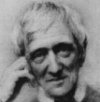
The parable of the lost sheepLuke 15,4-7 and Matthew 18,12-14 What man among you with a hundred sheep, losing one, would not leave the ninety-nine in the wilderness and go after the missiong one till he found it? And when he found it, would he not joyfully take it on his shoulders and then, when he got home, call together his friends and neighbours? "Rejoice with me", he would say "I have found my sheep that was lost".
|
Interpreting Scripture Correctly |
|
First ObservationJesus taught in a prophetic mannerThe first three Gospels - Matthew, Mark and Luke - called the Synoptics are quite different from the Gospel of John. John is the end product of theological reflection on Jesus in the Churches of Asia Minor. We will focus on the Synoptics because they incorporate the oldest traditions in a recognisable form. These three Gospels are really very unusual writings. They are not treatises dictated by a master. They are not life stories in the way we normally understand biographies to function. They are rather collections of short teachings and episodes strung together in an overall pattern. Perhaps, I can explain this through an example. Apprentices in the building construction will nowadays receive systematic instruction on many aspects of, say, masonry. They will study the strengths and weaknesses of materials (stone, brick, concrete, steel, wood). They will consider the functions of walls, supports, beams, trusses, and so on. They will learn a wide choice of laying bricks. The information will be available in methodical manuals that present the subject matter in an orderly fashion. Years ago that was not the way apprentices learned their skill. They would assist a master builder who would teach them from moment to moment as suggested by the job in hand. Now suppose there had been an excellent master whose teachings were so much appreciated that they led to the formation of a whole new school of masonry. Now suppose again that some early disciples who had known the master had, on the master's advice, taken snapshots of the work while the master was teaching. These snapshots might have recorded some striking samples of work: an unusual way of fixing a beam, perhaps; an intriguing combination of wood and concrete blocks; an eye-catching patterning of bricks; and so on. If various disciples had preserved albums with such snapshots, we would have a good idea of what the master had been teaching. And by comparing various photographs we could somehow reconstruct his original genius. The Synoptic Gospels are somewhat like that. They contain collections of 'snapshots' of Jesus' actions and words. The 'snapshots' have been arranged in a coherent presentation, as we shall see later, but they are still recognisable as originally separate units. To obtain a good idea of Jesus'way of teaching, we have to look at these original 'snapshots'. We can see from the snapshots how Jesus taught. He did not follow a syllabus. He did not present a systematic course of lectures. No, he preached the Kingdom of his Father as the moment demanded. He might draw examples from people's everyday life and use them to formulate parables. He would show his Father's love in action by healing the sick. He would explain, argue or question in response to whatever situation arose. We call this kind of teaching 'prophetic'; to distinguish it from the systematic disciplines we are used to in our schools. See this video on the parable of the lost sheep again. Note the distinctive prophetic features of (a) occasion, (b) prophetic word and (c) lesson.
|
|
|
Second ObservationMatthew's Gospel inserts the parable of the lost sheep within a larger section of teachings on taking care of weaker members of the community, the 'little ones'. Matthew probably knew a traditional instruction on pastoral care in the community in which various words of Jesus with the same theme had been put together. Matthew inserts the string into a sermon of Jesus addressed to the disciples:
Now see this video on how Matthew uses the parable of the lost sheep in his Gospel.
|
traditional instruction
oral catechesis
string of traditions |
|
Third ObservationLuke's Gospel preserves the parable of the lost sheep within a larger section of teachings on God's mercy towards repentant sinners. Luke wrote his Gospel for communities of Christians in the Hellenistic world of Syria, Asia Minor, Cyprus, Greece and Italy. No doubt one of the pastoral concerns of preachers was to urge their audiences to repent for their sins, pointing out that God welcomes sinners with open arms. Against this background, Luke or a source Luke depends on, strung together three of Jesus' prophetic teachings:
Now see this video on how Luke uses the parable of the lost sheep in his Gospel.
|
Hellenistic = under the influence of Greek culture Asia Minor = present-day Turkey
refrain |
|
ConclusionsI will formulate the conclusions in the form of Question & Answer Why could the parable of the lost sheep be given such divergent lessons?
Did Jesus himself not formulate the main lesson of each parable?
|
||
CreditsThe texts in our course Interpreting Scripture Correctly were written by John Wijngaards in 2009. Part of the contents is based on his earlier publications, in particular:
Illustrations in the video clip by Jackie Clackson. |
 |
 |
 |
 |
 |
|
|---|---|---|---|---|---|
| Facts |
 |
 |
 |
 |
|||